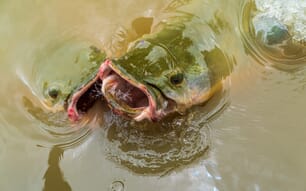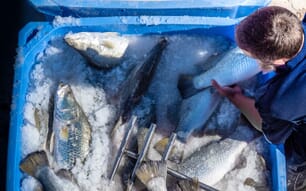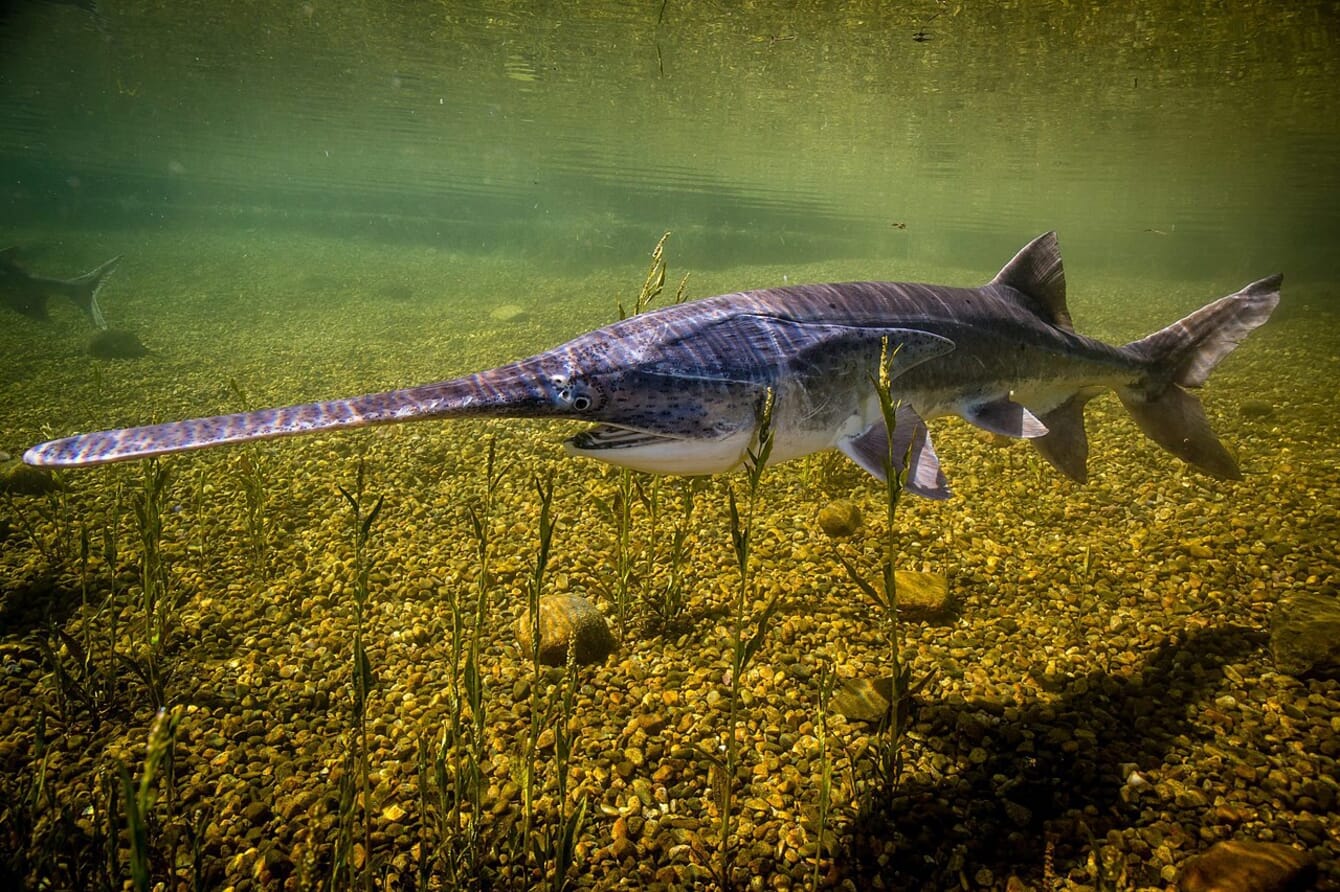
In modern times there have been two distinct species of paddlefish: the American paddlefish (Polyodon spathula) and the Chinese paddlefish (Psephurus gladius) – unfortunately, P. gladius was officially declared extinct in 2022 © USFWS
The American paddlefish, Polyodon spathula, belongs to the order Acipenseriformes, along with the various sturgeon species. This group of “ancient” fishes originated some 300 million years ago, and survived the Permian-Triassic extinction event, presumably as a result of enhanced genetic resilience attributed to a whole genome duplication early in their evolution (Redmond et al. 2023). There are fossil records of six distinct paddlefish species, but in modern times there have only been two: P. spathula from the Mississippi River Basin, and the Chinese paddlefish (Psephurus gladius) from the Yangtze River. Unfortunately, P. gladius has not been seen since 2003; it was officially declared extinct in 2022.
As a result, P. spathula is the last of a very long line of unique fishes. Although some stocks of P. spathula have been threatened by habitat loss, pollution and overfishing (Rasmussen and Graham 1998), paddlefish are not yet relegated to isolated remnant populations. Additionally, a number of introduced populations established across Europe and temperate regions of Asia have fared quite well over the past half-century (Vedrasco et al. 2001). Interest in paddlefish culture has expanded globally for many decades, and recent studies on its culture have been published by researchers from Romania, Bulgaria, Ukraine, Russia, Hungary and China.

P. spathula have been introduced to a number of countries around the world over the past half-century, with a number of operations throughout southern Russia producing millions of paddlefish eggs, fry and fingerlings – both for domestic distribution and for export to neighbouring countries © USFWS
In the US, laws pertaining to possession and trade of paddlefish vary from state to state. Unfortunately, the very regulations put in place to protect wild populations complicate – or even preclude – efforts to culture the fish commercially in many circumstances. Elsewhere, the species is increasingly viewed as a promising candidate for both polyculture and monoculture production. In many polyculture strategies it offers a much more lucrative alternative to bighead and silver carps.
In North America the paddlefish has been exploited for over a century for both its meat and roe (which is often compared to Sevruga caviar). Populations are particularly vulnerable to fishing pressure because they are long-lived and late to mature. Males typically do not reach maturity until 7-9 years, and females at 8-15 years. Additionally, the establishment of many dams and reservoirs throughout the fish’s natural range during the 1900s prevented access to upstream habitats necessary for reproduction. As a result, commercial and recreational fishing for the species have been highly regulated in recent decades.
Culture
Mature female paddlefish typically ovulate every 2-3 years, but there are reports of consecutive-year spawning in warmer regions and under captivity. Wild caught broodstock are often used by resource conservation agencies for spawning. Females suitable for captive spawning are 9 to 15 kg or larger, while males can reach maturity at 7 to 9 kg. Although they can display alarming behaviour during transport, floating belly up, once released they usually recover rapidly and generally exhibit acceptable maturation and gamete development when maintained in ponds.
Although riverine habitats are required for natural spawning, paddlefish can reproduce in captivity. Following several early trials yielding unreliable results (Purkett 1963, Needham 1965), artificial propagation techniques, based on methods developed for sturgeon, were adapted in the 1980s and have since been widely described. As is the case with sturgeon, determining females’ egg maturation status and likelihood of spawning is much more complex than in most other finfish. Depending on their size (typically 10 to 25 kg) and several other factors, mature female paddlefish can release 8,000 to 20,000 eggs per kg of body weight. Since female paddlefish ovulate within their body cavities, the preferred method for egg stripping involves making a small incision into the body cavity and expelling the ripe eggs for artificial fertilisation. The incision heals rapidly and captive females typically spawn multiple times during their lives. After fertilisation takes place, eggs are treated with Fuller’s earth or other compounds to prevent adhesive clumping during incubation. Mims et al. (1999) provide detailed methods for paddlefish propagation.
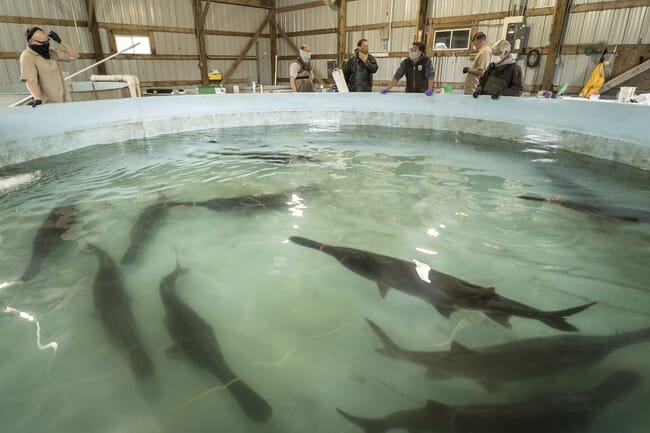
Mature female paddlefish typically ovulate every 2-3 years, but there are reports of consecutive-year spawning in warmer regions and under captivity – females ideally weighing between 9 to 15 kg or larger are suitable for captive spawning © USFWS
The preferred diet for paddlefish fry is typically based on live Daphnia (Webster et al. 1991), but superior results have occasionally been attained with starter diets developed for other species (Kurten et al. 1992, Kroll et al. 1994). Fry production in large quantities, however, requires fertilised ponds managed to maximise production of Daphnia and similar zooplankton. Upon reaching 8-10 cm, juveniles can reliably consume pelleted diets of the appropriate size.
While much of the interest in paddlefish culture over the years has focused on raising female fish to a size and age (over 10kg and over 10 years old) at which they can reliably produce caviar, the species also provides high-value fillets and steaks reminiscent of sturgeon. Low stocking densities are the norm for polyculture or reservoir ranching strategies, while higher density monoculture using 32 percent protein floating feed has also been accomplished, including in cages. Paddlefish culture is decidedly more successful in water temperatures of 15 to 25o C). Stress from high temperatures, marginal oxygen levels and handling mortality all tend to complicate warm water grow-out.
Beyond North America
Paddlefish have been introduced to a number of countries around the world over the past half-century. Hoover (1999) listed some 15 countries that had imported paddlefish from 1993 to 1996. Raymakers (2002) indicated that roughly 1 million live fish and fertilised eggs, combined, were exported from the US between 1993 and 1997. Fertilised paddlefish eggs and newly hatched fry can be shipped, with good survival rates, for up to 72 and 48 hours, respectively.
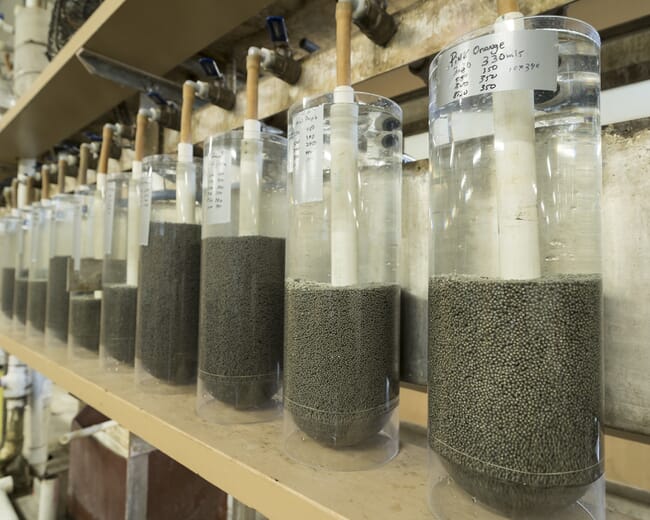
Mature female paddlefish can release 8,000 to 20,000 eggs per kilogram of body weight, depending on their size (typically 10 to 25 kg) © USFWS
Paddlefish were first introduced to the former Soviet Union in 1974, and although few of the fry in the original shipment survived, some went on to mature and serve as broodstock. Prior Russian expertise in sturgeon hatchery management was a significant factor in this success. More fry were shipped in 1977, and in 1978 juvenile paddlefish were sent to Moldova. They too matured to become breeding stock, with their offspring then being sent to several other Soviet bloc nations. In recent years, a number of operations throughout southern Russia have produced millions of paddlefish eggs, fry and fingerlings – both for domestic distribution and for export to neighbouring countries.
Paddlefish ranching in lakes and reservoirs has proved successful in Eastern Europe, particularly in Ukraine. The stability of such systems allows for paddlefish to be stocked at very low densities (10 to 30 per hectare) and left to grow to maturity. This long-term approach is best suited for caviar production, but overall yields may not be sufficient to guarantee profitability. Depending on the specific location, permitting constraints and poaching often prevent successful ranching operations.
Paddlefish have also been introduced into Germany, France, Bulgaria, Belgium, Poland and the Czech Republic. However, European Union regulations do not allow for their culture in lakes, reservoirs or other public waters. Although most of the original paddlefish shipments to Europe were undertaken in compliance with official requirements, the species is now a source of concern due to its non-native status and potential invasive tendencies (Jelkic and Opacak 2013).
China first received paddlefish fry from the US in 1988, with a follow-up shipment of fertilised eggs in 1991. By 2001 some fish had matured and spawned (Xiong et al. 2008), and many more fish have been imported from both the US and Russia since that time. Hundreds of millions of paddlefish have been stocked across some 20 provinces in China, particularly in the eastern part of the country. As a result, a number of nutritional studies focused on paddlefish larviculture and grow-out are being conducted by Chinese researchers (Wu et al. 2015, Liu et al. 2018 and 2019).
Reservoir ranching is practiced in some locations in the country (Wang et al. 2013), and paddlefish have been widely seen as a superior alternative to big-head carp in traditional polyculture combinations (Gu et al. 2012). Paddlefish monoculture is also practiced, typically in floating net-pens in large impoundments. Natural zooplankton serves as feed, and producers utilise night-time lighting to concentrate this free source of food for the paddlefish. Annual yields are typically 800 g fish per cubic metre.

The preferred diet for paddlefish fry is typically based on live Daphnia, although superior results have been attained with starter diets developed for other species © USFWS
Current and future prospects
As novel approaches to polyculture are advancing in a number of countries, the paddlefish has demonstrated several attractive characteristics. It offers the services of a filter-feeding species while producing high-value products comparable to those of sturgeon. Paddlefish may be particularly suited for polyculture in in-pond raceway systems when stocked into the open pond component. Brown et al. (2011) reported paddlefish yields of 990 kg per hectare when stocked in polyculture, with channel catfish using an in-pond raceway system. Catfish were stocked in raceways while paddlefish and tilapia were allowed to roam freely in the open pond area. The species may also be appropriate for split-pond production systems.
When long-term culture is feasible, the production of paddlefish caviar has significant potential. If all-female stocks could be produced, the effort would easily pay for itself. Shelton and Mims (2012) determined that, like most sturgeon species, female paddlefish are WZ while males are ZZ. If fertile WW females can be produced through gynogenesis, all-female WZ stocks could then be produced by crossing them with ZZ males. Such techniques have been used successfully in a number of fishes.
Note from author
An excellent reference for all aspects of P. spathula production can be found in Paddlefish Aquaculture, edited by Steven D. Mims and William L. Shelton. John Wiley & Sons 2015.


